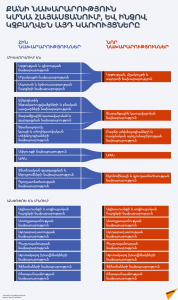Stages of reforms in public sector in Armenia
After the independence, one of the problems of the newly elected government of the Republic of Armenia was the need for public administration to move from a large scale Soviet institutions and governing bodies to a more efficient governance and market economy inherited from the USSR. Conditionally, the public sector reforms can be divided into four stages: During the First Stage (1999-2003), the administrative system of public administration was rebuilt, management structures were unified, government institutions were formed, and a professional civil service was created. Then, in the second stage (2003-2008), the main objective was to improve public service responsibility, accountability, service delivery, management models and mechanisms, civil society participation in political decision-making, and effective and transparent public relations.The third stage (2009-2014) covers the Eastern Partnership Program in May 2009, the main objective of which was to strengthen relations between Armenia and the EU, adhering to the principles of democracy and good governance. Within the framework of the Eastern Partnership, the Public Administration Reform Commission was established. The committee should follow the public administration reforms in partner countries to be in accordance with the already developed European standards. During the years of 2009-2014the use of the “Malberri” electronic document management system by all regions of Armenia, ministries and almost all communities was an important achievement. This system allows online tracking of the process of applying to public administration bodies, organizing the circulation of documents between state bodies electronically. The fourth stage (2015 up to now) conditionallylincludes includes the reforms of public administration after the Constitutional reforms of 2015 up to now and the current government program of RA.
Governmental Structural Changes in 2000-2018
Having studied the decrees of the Armenian Presidents from 2000 to 2018 on the structural changes of the government, one can conclude that the joint of ministerial committees or committees’ additions were arbitrary, and there were no substantiations on the structureand there are no substantiations It is difficult to understand within the framework of the assessment whether the defined structure enables effective public management and ensures compliance with the basic principles of public administration.
For example, in 2005, the Emergency Situations Department, the State Migration Committee and the Refugee Department, were reorganized by the Ministry of Territorial Administration, and no explanation was given to it. And in 2014, according to the structure of the Armenian government,after the reorganizations and renaming, 18 ministries were set up. Then, the city-building committee was created instead of the Urban Development Ministry. As a result, the Charter of the Committee naturally duplicated the Ministry’s charter, with the exception of some of the changes made in the narrative. In terms of content-quality, the structure of the staff actually did not change, and the quantitative comparison is somewhat different. when the staff of the Ministry of Urban Development had six departments and six divisions, the Committee staff had seven departments and three divisions. That is, again a structural change and nothing else.
One of the most important achievements on the way of public policy reform can be also considered the RA CSC with the support of EU experts (SIGMA and the EU Support Program for Civil Service Reforms) in 2015, “Civil Service Reform Strategy” and “Civil Service Reform Strategy Implementation Action Plan” »[I]:
The aim of the Civil Service Reforms is to create a civilian, professional and decent civil service system in line with the best international public governance practices and modern standards and principles. The reforms will be implemented by 2020[ii] , after which it is assumed that a qualitatively new system will operate in Armenia. According to the Eastern Partnership Estonian Center for Public Administration of the EU Eastern Partnership Countries, Armenia is called a “Silent Reformer” among foreign countries thanks to the essential and continuous progress in line with European standards in various areas of public administration. The efforts of the country to create predictable and transparent public administration have generally been successful. It is also important to highlight the successes in the field of competition protection, effective infrastructure, ICT development, as the contradiction between the country’s political and economic structures has hindered the reform process for a long time. On September 3, 2013, RA President SerzhSargsyan’s decision on Armenia’s accession to the Eurasian Economic Union has somewhat affected the process and results of public administration reforms. In 2012, in the context of open and transparent governance, Armenia was in a leading position in the region, with an unprecedented decline in Armenia in 2014, declining even in 2010. In 2014, Armenia regressed in a number of areas of public administration, in particular, in terms of transparency and government expenditure efficiency. The change of government in the spring of the same year contributed to the strengthening of an oligarchic economic policy.
The current agenda of the optimization and efficiency enhancement of the Armenian government system
Returning to the government’s current political agenda, we can state that the Government of Armenia is launching a process of optimizing the governance system and improving its efficiency. Based on the announcement made by Prime Minister NikolPashinyan on changes in government structure, one can expect a number of changes. First, perhaps the most tangible change relates to the Government’s structure, in particular, the number of ministries that has reduced from 17 to 12 (see Appendix 3), and will also be reduced to the position of the first deputy prime minister.

Analyzing the governance optimization process, we also need to consider whichis the source of the changes. These can include promises made during elections, commitments under international treaties, public pressure, and more. We think that in case of Armenia, the above factors play a role.
Referring to the same speech of the prime minister, we can see that the motives for making the changes are also the public promises made during the elections (“We have promised to simplify the procedures, especially the procedures of business operations.” If we have many ministries, it means the people working in them have to deal with something, something that needs to be settled:It is impossible to keep ministries without giving them powers. “[iii].
Perhaps this prime minister’s statement once again raises the problem of repetitive overruns of the ministries whose optimization can also lead to the reduction of corruption risks.
The Factors Affecting the Process
In the international impetus, we cannot overstep the last year’s ratification of the Comprehensive and Enhanced Partnership (AGP) Agreement between Armenia and the European Union, considering that the prospect of deepening cooperation with the EU often promotes the reform process in developing countries. The EU provides financial and expert support to the Republic of Armenia in the field of governance reform and strengthening. So in this case, the EU is a powerful catalyst for change.
There is also a factor of public pressure. In one of his interview, Member of NA Varazdat Karapetyan pointed out that people have great expectations, emphasizing the importance of institutionalization between the public sector and the people.
When speaking about effective governance reforms, we cannotemphasize the importance of transparent practice. Let’s not forget that the lack of incomplete andopem information about the government’s activities has created a number of problems for Armenia as a basis for oligarchy prosperity and systemic corruption. The main feature of well-organized government accountability is the availability of transparent financial information that should be affordable and accessible to all, becoming one of the key tools for public oversight.
We cannot come to the problems that create certain risks for organizing an effective optimization process. These include a lack of professional human resources, a lack of motivation strategy for civil servants, and, in general, a not so attractive civil service image, poorly-paid remuneration system, ineffective state bodies, limited resources and so on.
Bearing in mind the overall process of optimizing Armenia’s governance system, its capabilities and risks, it should be noted that public administration reforms is an ongoing process. Gradual optimization of the management system stems from the need to adapt to global changes in the world. This process is unique to not only developing countries, but also developed countries continue to rebuild their public management systems. The Government’s scope, structure, cost, staff optimization policy aims to increase the functionality of the public sector, the coordination and quality of the services provided, reduce the budget deficit, and to bring the public services to the impact of demographic changes.
We also consider it important to clarify what we can expect after the optimization of the management system. In particular.
- management system reorganization;
- development of e-governance and e-services;
- Raising public administration efficiency;
- Reduction of administrative barriers (bureaucratic brawls);
- Improving the quality of services provided and a professional management system that enjoys public confidence.
The transformations are not free of risks and are of particular importance in the context of non-violent people.
- system functional review,
study of the international experience and previous reforms of public administration system and expert consulting
Also, it is important to carry out a functional analysis of the public management system and assessment of the needs to eliminate unnecessary functions, to increase missing functions and to implement them rationally,have a clear actions plan and show how the planned changes help to achieve the goals,
- ensure staff proper training for effective reforms,
- create monitoring and control mechanisms,
- take into account the context, the country’s legitimate traditions, administrative structure and cultural peculiarities, which in some cases determine the attitude of the people towards the management system’s transformation tools and the possibility of effective use of one or another instrument.
There are no guarantees that the changes will have a positive impact on the transformation of the public administration system. Therefore, in the process of transformation, it should not only be based on common impressions. Information about the transformation, its analysis and interpretation should be made to be clear to non-experts, including possible impact assessments, allowing for follow-up of the transformation process and responding to them incompatible with the pre-defined standards. It will take time to show whether it will reach the government of Armenia or not.
[i] https://www.e-gov.am/protocols/item/613/ [ii] http://eap-csf.eu/wp-content/uploads/PAR-Abraham.pdf [iii] https://www.aravot.am/2019/01/18/1010993/ [iv] http://eap-csf.eu/wp-content/uploads/PAR-Abraham.pdfReferences
Bibliography
Authors: Andranik Hovhannisyan, HeghineAleksanyan, Mariam Jamalyan. © All rights reserved.
Translator: Anna Ghulijanyan









